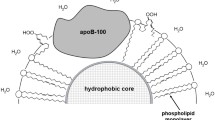Abstract
Oxidative modification of human blood LDL induced by Cu2+, NaOCl, or 2,2-azobis-(2-aminopropane hydrochloride) was followed by their partial aggregation. Separation of oxidized LDL into aggregates and nonaggregated particles showed that they are characterized by a similar degree of oxidative modification. In contrast to nonaggregated particles, LDL aggregates in the same concentration significantly increased cholesterol content in smooth muscle cells from the intact (no involoved in atherosclerosis) human aortic intima. Our results indicate that atherogenicity of LDL oxidized by various factors is mainly associated with the formation of aggregates, but does not depend on the degree of oxidative modification.
Similar content being viewed by others
References
O. M. Panasenko, Yu. Arnkhol’d, and V. I. Sergienko, Biol. Membrany, 19, 403–434 (2002).
O. M. Panasenko and V. I. Sergienko, Ibid., 10, 341–382 (1993).
O. M. Panasenko and V. I. Sergienko, Byull. Eksp. Biol. Med., 131, No. 5, 484–494 (2001).
J. A. Berliner and J. W. Heinecke, Free Rad. Biol. Med., 20, 707–727 (1996).
L. J. Hazel and R. Stocker, Biochem. J., 302, 165–172 (1994).
J. W. Heinecke, Coron. Artery Dis., 5, 205–210 (1991).
H. F. Hoff and J. O’Neil, Arterioscler. Tromb., 11, 1209–1222
Y. Kawabe, O. Cynshi, Y. Takashima, et al., Arch. Biochem. Biophys., 310, 489–486 (1994).
O. H. Lowry, N. J. Rosebrough, A. L. Farr, and R. J. Randall, J. Biol. Chem., 193, 265–275 (1951).
R. Maebe, H. Shimasaki, and N. Ueta, Biochim. Biophys. Acta, 1215, 79–86 (1994).
A. N. Orekhov, V. V. Tertov, I. D. Novikov, et al., Exp. Mol. Pathol., 42, 117–137 (1985).
V. V. Tertov, V. V. Kaplun, S. N. Dvoryantsev, and A. A. Orekhov, Biochem. Biophys. Res. Commun., 214, 608–613 (1995).
V. V. Tertov, V. V. Kaplun, and A. A. Orekhov, Atherosclerosis, 138, 183–195 (1998).
V. V. Tertov, I. A. Sobenin, and Z. A. Gabbasov, Biochem. Biophys. Res. Commun., 163, 489–494 (1989).
V. V. Tertov, I. A. Sobenin, Z. A. Gabbasov, et al., Circ. Res., 71, 218–228 (1992).
Author information
Authors and Affiliations
Corresponding author
Additional information
__________
Translated from Byulleten’ Eksperimental’noi Biologii i Meditsiny, Vol. 143, No. 2, pp. 159–162, February, 2007
Rights and permissions
About this article
Cite this article
Panasenko, O.M., Mel’nichenko, A.A., Aksenov, D.V. et al. Oxidation-induced aggregation of LDL increases their uptake by smooth muscle cells from human aorta. Bull Exp Biol Med 143, 200–203 (2007). https://doi.org/10.1007/s10517-007-0050-x
Received:
Issue Date:
DOI: https://doi.org/10.1007/s10517-007-0050-x




